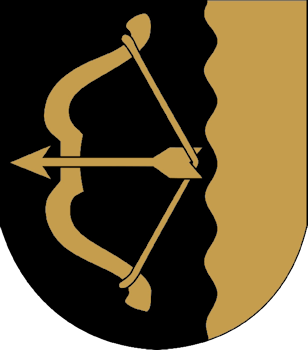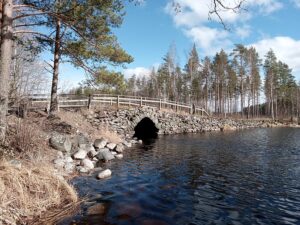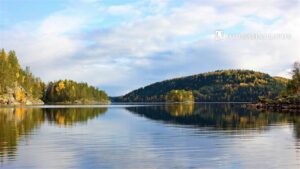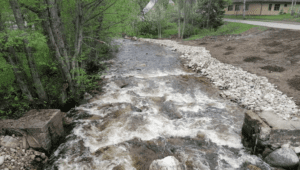Things to See
Vuokalan Mill Museum
The first mill in Vuokala was established in the 1860s, which was converted into a steam mill in 1898, and in the early 1900s a hydroelectric power plant was built to generate electricity. Savonranta was one of the first rural municipalities in Finland to be electrified.
The present mill building dates back to 1937. The mill’s golden age was in the 1950s, when four millers worked and grain from nearby municipalities was milled day and night. Today, the mill is owned by the Savonranta Development Foundation and is kept open by the Savonranta Craftsmen’s Association.
Between 2001 and 2003, the mill was renovated with the support of the Vuokala-Savonranta Fishing Tourism Conditions and Future project. The Vuokala mill is a good place to see the mill’s machinery, which is in good condition and practically in working order. The mill’s wooden machinery has four floors, and the grain travels as much as four kilometres on its way to wheat flour.
The power plant ceased operations in 2020, when the Vuokala rapids were rehabilitated and electricity sales to the national grid became unprofitable.
The mill also hosts art exhibitions during the summer and houses a craft exhibition and shop of the Savonranta craftsmen and a guide point for the Kolovesi National Park. There is a guest marina and two restaurants in the immediate vicinity of the mill.
Lamminniementie 6. Open Tues-Fri 10-16, in summer also Sat 10-14. 044 990 1357 Savonranta Handicraftsmen Association.




Saimenen Mill Museum
The Säimen mill is located in the village of Säimene in Savonranta (the municipality of Savonranta joined the city of Savonlinna at the beginning of 2009). The mill has been located there since 1880. The current mill building dates back to 1937 and was in operation until 1960. The Säimen river, which flows next to the mill, provided power for the mill and the generator that produced electricity. The mill was leased by the Savonranta Society from the municipality of Savonranta for museum use in 1978. Today the mill is owned by the Savonranta Development Foundation.
In the mill building you can see a large part of the mill’s wooden machinery and the tools used in the mill. The mill building, which serves as a museum of local history, also contains exhibits related to logging, forestry, agriculture and domestic life.
In addition to the mill, there are other buildings on the museum site that have been moved from other parts of the Savonranta area. The building next to the mill, called Airaan tupa (Airaa’s cottage), represents a rather modest way of living typical of the area. There is also a smoke sauna, a blacksmith’s hut with tools, a stable room with objects related to horses and their use, objects related to men’s and women’s manual and soft work and farming, and, most recently, a restored 1950s dairy barn.
Piippu Hall
Pippu Hall is a unique performance space for the arts. Art exhibitions are held in summer. The space is managed by the Cultural Office of the City of Savonlinna. Piippuhalli can be found on Facebook and Instagram. Sahakuja 8 58300 Savonranta. In the summer of 2021, the documentary film Paasselän Pirut by Axel Strachnoy was shown, about the light phenomena that can be seen above the meteorite lake of Paasvede.


Savonranta House
Savonranta House is the community house. Exhibitions of Savonranta’s intangible cultural heritage are under construction in the building, which will open during the summer. During the summer, the house will host a small Ukrainian café during the opening hours of the exhibitions. The Reading Circle will meet regularly at the house and invite guests from the Ruusintorpa Writers’ Syndicate to talk about their work and production. The house also has a meeting room which can be used for meetings and parties. All events are announced on the society’s facebook page. [Lamminniementie 3, Savonranta].

Lake Paasselkä
Paasselkä (earlier Paasivesi, both names roughly mean ‘Stone lake’) is an oval-shaped lake formed in an eroded impact crater in Southern Savonia, Finland. The lake, which is a part of Orivesi, which is in turn part of the Greater Saimaa, is devoid of islands which makes it different from other lakes in the region. Paasselkä is also unusually deep, 75 m at the deepest point.
The Paasselkä impact occurred roughly <1800 million years ago (Statherian period of the Paleoproterozoic)[1] and affected Paleoproterozoic crystalline rocks and some overlying sandstones of the Baltic Shield. Because of the unusual shape and associated magnetic anomalies, Paasselkä was suspected to have an impact origin long until it was confirmed after a deep drilling in 1999 making it the ninth known impact crater in Finland. Unlike many Finnish craters, it does not seem to have been buried under layers of sediment.
Orivirran fortress
Orivirran saarto is a ruin of a 16th-century fortress located in Savonranta. It is believed to be built some time between 1540 and 1550 and was used until the beginning of the 17th century. Its status was to be an early warning for the St. Olaf’s Castle which is still located 50 km to south. It has a four cornered layout with dimensions of 60 m by 20 m build from stones and an outer fortress around 65 m by 75 m. When operational it had 300 to 400 soldiers and 5 to 10 cannons.
In 1592 Russians and Cossacks destroyed the fortress. It did not survive after that and today there exists only some ruins of the fortress with a memorial stone.


Pienivirta stone bridge
The Pienivirra stone bridge, located in the strait between the mainland and Linnosaari, is a single-opening, vaulted bridge built of slate and connected to the first land road in Savonranta. The bridge and its surroundings are of transport and architectural historical value and are part of a nationally significant built cultural environment.
Ruusintorppa
Savonranta writer’s residence Ruusintorppa.
Donated by author Tauno Yliruus and textile artist Ingeborg Yliruus, the summer oasis serves as a writer’s residence for the National Cultural Foundation in Savonranta.
The residence is given on application for the summer month for the writer’s or translator’s working and vacation use. Kesäkeidas has operated as a writer’s residence since spring 2010.



Kolovesi National Park
Kolovesi is a paddler’s and hikers paradise, where rocky cliffs rise over the narrow lake channels that form part of the vast labyrinthine Saimaa Lake System. Ancient rock paintings give insights into how Finland’s early settlers lived in harmony with nature thousands of years ago. With luck you might encounter a curious Saimaa ringed seal. This is one of the best places to spot these unique lake seals.
Kolovesi National Park is a preserve for the archipelago nature of Lake Saimaa wilderness and old-growth forests over a hundred years of age. Rock paintings thousands of years old adorn the sheer rock faces. This is a quiet and sheltered paradise with a labyrinth of islands.








